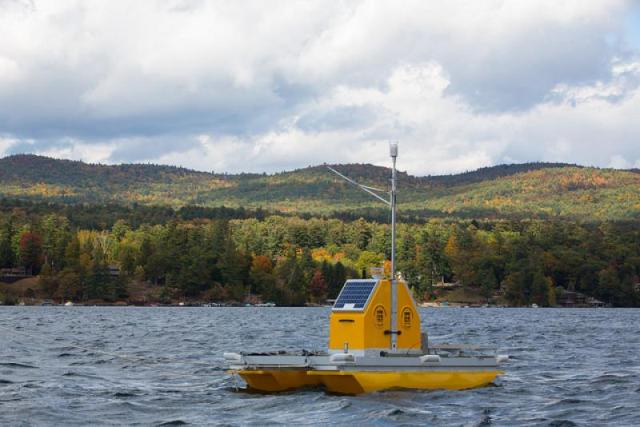Oct 20 2014
The Jefferson Project at Lake George today announced new milestones in the multimillion-dollar collaboration that seeks to understand and manage the complex factors impacting Lake George, a pristine natural ecosystem and cornerstone of New York’s tourism industry. Through their groundbreaking partnership, Rensselaer Polytechnic Institute, IBM, and The FUND for Lake George have developed preliminary models of key natural processes within the watershed.
As part of the first phase of the project, a network of 12 sensor platforms including vertical profilers and tributary monitoring stations are now being deployed around Lake George and its tributaries, providing an unprecedented amount of data for researchers.

A new data visualization laboratory at the Margaret A. and David M. Darrin ’40 Fresh Water Institute (DFWI) in Bolton Landing will be unveiled on Friday, Oct. 17. The new 2,000-square-foot laboratory features advanced computing and graphics systems that allow researchers to visualize sophisticated models and incoming data on weather, runoff, and circulation patterns. The data visualization laboratory will display streaming data from various sensors in and around the lake in real-time.
The three project partners offer unique expertise in fields as varied as biology, freshwater ecology, computer science, physics, engineering, cyber-physical systems, environmental advocacy, and remote sensing. Working together, those experts are developing novel ways of collecting, modeling, and analyzing data from the lake and its surrounding environment.
Since the Jefferson Project launched in June 2013 with the goal of making Lake George the world’s “smartest” lake, a bathymetric and topographic survey conducted by boat and plane has mapped the lake bed, shoreline, and watershed. Now, within the data visualization laboratory, scientists will be able to zoom in as close as half a meter on high-resolution 3-D models of the lake and surrounding area, a degree of detail unprecedented for a lake of this size.
Preliminary models of the lake’s circulation and runoff, developed with data from existing bathymetry and a 30-year study of Lake George, will be refined and enhanced with the new high-resolution bathymetric and topographic survey data. In addition, a combination of shore-based weather stations and lake-based sensor platforms – connected via an advanced cyber infrastructure – will be deployed to monitor the temperature of the air and water, flow rates of tributary streams, lake currents, and the amount of oxygen and algae in the water as well as additional water quality indicators.
The sensor data not only improves the accuracy of the early models, it also opens opportunities for future analytics. To gain a complete view of the lake’s ecosystem, project partners will combine biological data with the circulation and other models, to create a “food web model” that simulates the biological impacts physical and chemical changes have on fish and other species in the lake.
“Today marks the beginning of a new era for Lake George. Driven by emerging technologies, guided by visionary leadership, and enabled by extraordinary generosity, we will see the lake in new and important ways,” Rensselaer President Shirley Ann Jackson said. “Building on a nearly 50-year foundation of Rensselaer research and buoyed by new partnerships, we are developing a deeper understanding of the life of the lake. Doing so will facilitate the preservation of Lake George, and the development of a model that will help preserve lakes around the world and secure the global supply of fresh water.”
With the Jefferson Project’s sophisticated lake environmental monitoring and data analysis capabilities, scientists are learning how the lake has changed in the past, observing how it functions in real time, and will be able to predict how different variables could impact this valuable resource in the future.
The impact of the Jefferson Project will be felt globally – the technology IBM has invented and adapted for the project as well as the innovative approach of establishing an interdisciplinary partnership will provide a model for future lake studies.
“Significant progress has already been made over the past year with the completion of the survey data and preliminary models. Now we’re bringing state-of-the-art visualization capabilities to this complex project and starting to collect more sensor-based data that will help us more precisely understand and remedy the lake’s challenges,” said John E. Kelly III, senior vice president and director of IBM Research, and a Rensselaer trustee.
“The pace-setting progress being made in harnessing science and technology to guide lasting protection of Lake George has been breathtaking and inspiring,” said Jeff Killeen, chairman of the FUND for Lake George. “We are redefining how to secure lake health at a critical time of unprecedented threat but extraordinary opportunity. The FUND for Lake George is honored to be partnering in this history-making endeavor.”
A ribbon-cutting ceremony for the data visualization laboratory will be held at 10:30 a.m. Friday, Oct. 17, at the DFWI.
Rensselaer President Dr. Shirley Ann Jackson will be joined at the event by Dr. John E. Kelly, senior vice president and director of IBM Research, and Jeffrey M. Killeen, board chairman of the FUND for Lake George, in offering updates on the progress the Jefferson Project has made toward making Lake George the world’s smartest lake.
The event will also include an announcement about a leadership gift to Rensselaer that will support ongoing research at the data visualization laboratory.
Rick Relyea, the newly appointed director of the Jefferson Project for Rensselaer, Professor, and David M. Darrin ’40 Endowed Chair, will also be introduced and will share his vision for the project.
Contact: Emily Donohue
Phone: (518) 276-6542
E-mail: [email protected]